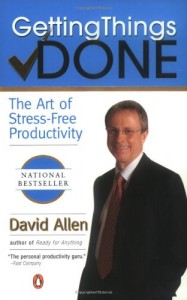By David Allen. 2001.
Chapter 1: A New Practice for a New Reality
Chapter 2: The Five Stages of Mastering Workflow
Three requirements to make the collection phase work:
- Every open loop must be in your collection system and out of your head.
- You must have as few collection buckets as you can get by with.
- You must empty them regularly.
Three things to go on your calendar:
Time-Specific Actions
Day-Specific Actions
Day-Specific Information
No More “Daily To-Do Lists”
No-action systems fall into three categories: trash, incubation, and reference.
It’s one thing to write down that you need milk; it’s another to be at the store and remember it.
You need to be able to review the whole picture of your life and work at appropriate intervals and appropriate levels. … This is where you take a look at all your outstanding projects and open loops, at what I call the 10,000-foot level on a weekly basis. It’s your chance to scan all the defined actions and options before you, thus radically increasing the efficacy of the choices you make about what you’re doing at any point in time.
After checking your calendar, you’ll most often turn to your Next Actions lists. These hold the inventory of predefined actions that you can take if you have any discretionary time during the day. If you’ve organized them by context (At Home, At Computer, etc) they’ll come into play only when those contexts are available. … Projects, Waiting For and Someday/Maybe lists need to be reviewed only as often as you think they have to be in order to stop you from wondering about them.
Everything that might potentially require action must be reviewed on a frequent enough basis to keep your mind from taking back the job of remembering and reminding. In order to trust the rapid and intuitive judgment calls that you make about actions from moment to moment, you must consistently retrench at some more elevated level. In my experience, that translates into a behavior critical for success: the Weekly Review.
The Threefold Model for Evaluating Daily Work
There are three different kinds of activities you can be engaged in:
- Doing predefined work
- Doing work as it shows up
- Defining your work
There is a simple but profound principle that emerges from understanding the way your perceptive filters work: you won’t see how to do it until you see yourself doing it.
One of the most powerful skills in the world of knowledge work, and one of the most important to hone and develop, is creating clear outcomes. This is not as self-evident as it may sound. <more>
Because your head is not the place to hold things, you’ll need something to manage your triggers externally.
Once you know how to process your stuff and what to organize, you really just need to create and manage lists.
Your calendar is actually a form of a list—with time and day-specific action reminders listed chronologically.
When considering whether to get and use an organizer, and if so, which one, keep in mind that all you really need to do is manage lists.
If your filing system isn’t fast, functional, and fun, you’ll resist the whole process.
The lack of a good general-reference system can be one of the greatest obstacles to implementing a personal management system.
It should take you less than one minute to pick something up out of your in-basket or print it from e-mail, decide it needs no action but has some potential future value, and finish storing it in a trusted system. If it takes you longer than a minute to complete that sequence of actions, you have a significant improvement opportunity, since you probably won’t file the document; you’ll stack it or stuff it instead. Besides being fast, the system needs to be fun and easy, current and complete.
Steps in the Weekly Review
- Put all loose papers (miscellaneous scraps, business cars, receipts) into your in-basket.
- Process your notes.
- Review Projects list. Evaluate the status of projects, goals, and outcomes one by one, ensuring that at least one current kick-start action for each is in your system.
- Review Next Actions lists.
Steps in Weekly Review
- Put all loose papers (miscellaneous scraps, business cars, receipts) into Input Buffer box.
- Process your notes. Collect all post-it notes into one place. Get Note Sorting binder. Sort each note into its proper section: Tasks, Nontasks, Events, etc.
- Review last week’s calendar. Collect any unfinished tasks.
- Review Projects list.
- Review Next Actions lists.

